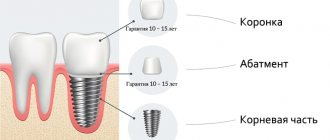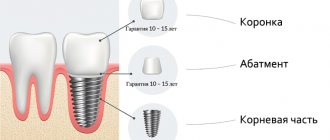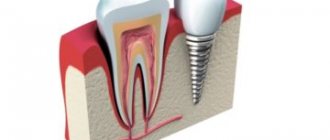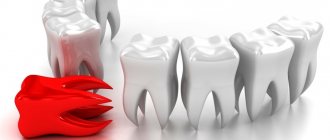Single-phase implantation involves non-surgical restoration of teeth with immediate loading. The implant is installed without incisions, through a small puncture in the jaw bone; the crown can be installed during the same visit. Immediately after implantation of the titanium root, a lightweight metal-plastic prosthesis is installed. When complete healing occurs, the temporary crown is replaced by a permanent one.
Indications and contraindications
Single-phase implantation is used in cases where two or more teeth are missing in a row. If one unit is lost, it is advisable to use other methods.
Since the procedure is low-traumatic, the number of restrictions for its implementation is minimized. Contraindications include temporary circumstances, as well as absolute restrictions. Temporary, that is, removable contraindications are:
- Restrictions during pregnancy and lactation.
- Acute diseases.
- Caries, the presence of inflammatory processes in the oral cavity.
Absolute contraindications include:
- Mental disorders, central nervous system.
- Disturbances in the functioning of the cardiovascular system, immune abnormalities.
- Diabetes.
- Progressive oncological diseases.
Advantages and disadvantages
Single-phase implantation does not involve extensive intervention. All that is needed is a gap in the gum for implantation. The procedure does not take much time, and the probability of engraftment is 100%. Among the main advantages of the method:
- Minimal trauma to gums and bone tissue.
- Fast adaptation and minimal healing period due to gentle effects.
- The prosthesis is installed immediately or after one or two days.
- Very high survival rate.
The disadvantages include the need for the patient to be 100% healthy at the time of implantation. If there is an infection in the body, the likelihood of rejection increases. In some cases, it is better to use the classic implantation protocol, which involves two stages with breaks for healing.
Video about immediate dental implantation in an aesthetically important area.
Find out about the premium class implantation system at an economy price!
ROOTT implants from Trate AG. ROOTT implant system manufactured by Trate AG.
Single-phase implantation in one day
An extracted tooth without timely restoration leads to a series of dental problems. In particular, neighboring teeth, having lost lateral support, begin to move to the side, may lose stability, become loose and will soon require removal. That is why clinical pictures where 2-3 teeth are missing in a row are quite common. Single-phase implantation is an immediate loading protocol. This means that after the titanium rod is implanted into the bone tissue, it is covered with a lightweight prosthesis. The aesthetic side of the problem is solved immediately, and the patient receives full, beautiful teeth. Replacing temporary metal-plastic prostheses with permanent ones is possible after 12 months, when the implants have completely fused with the bone.
Stages of single-phase implantation
First of all, preparation is needed, which includes examination, general tests, CT and x-rays, and sanitation of the oral cavity. When the preparatory measures are completed, you can begin implantation:
- The patient is given anesthesia.
- A puncture is made in the gum through which the implant is screwed.
- A lightweight temporary prosthesis can be installed immediately, or one to two days after implantation.
- A mandatory stage of implantation is engraftment control. For the first year, follow-up examinations are required every month.
- After a year, the temporary prosthesis can be replaced with a permanent one.
Advantages of monoblock design
The main difference between single-phase implantation and other systems is the use of special monoblock implants. Through the efforts of European developers, a unique implantation system was created that has:
- minimal trauma. A single-phase implant is installed through a small puncture in the gum, while classical implantation involves a complex operation with double tissue cutting: the first for implantation of the implant, the second for installing an abutment;
- almost complete painlessness. The procedure allows you to calmly survive not only the placement of the implant in the jaw tissue, but also the healing period, even for people with a low pain threshold;
- quick rehabilitation. Much less trauma compared to classical technologies allows you to minimize the risk of complications, and it is easy to endure the period of tissue restoration.
For the first time after the installation of implants, it is worth eating soft or liquid foods instead of solid foods, with special emphasis on foods rich in vitamins and minerals.
Several days after implantation (especially during the reconstruction of maxillary teeth), periodontal swelling may be observed. The swelling quickly subsides, and until then painkillers prescribed by your doctor will help you cope with the pain.
The use of a monoblock design allows you to almost immediately restore the chewing functions of your teeth. With complete edentia, it takes only 3-4 days to restore the dentition. The time savings compared to classic implantation systems are simply enormous.
The reliability of the single-phase system is beyond doubt among dentists and patients who have undergone dental reconstruction procedures. According to statistics, less than 3% of monoblock implants are rejected, despite the fact that the probability of rejection with classical implantation reaches 5%.
Cost of dental implantation in Moscow
The price of dental implantation depends on many factors. First of all, it is influenced by the implant, the amount of auxiliary work, examination, cost of the crown and other factors. The cost, depending on the chosen implantation protocol, can vary from 28,000 to 40,000 rubles and more. Single-phase Roott implantation Roott implantation involves the use of innovative monoblock implants that do not require separate installation of abutments. They make the process as simple as possible. To install such implants, no incisions or stitches are needed, which means the recovery process is much faster, without hematomas and swelling.
Types of one-stage implantation
There are three types of implantation in place of a newly extracted tooth:
- After implantation of the implant into the socket of the extracted tooth, the gum is sutured and all subsequent manipulations are performed after complete engraftment.
- The subgingival part of the implant is introduced together with a gum former (typical or custom-made depending on the specific situation). With this type, single-phase dental implantation makes it possible to achieve a neat and natural appearance of soft tissue in the area of implantation.
- When using the third type of this procedure, no more than three visits to the dentist will be required. During the first, an impression will be taken to create a temporary prosthetic structure. On the second, the doctor will insert the implant and install a temporary prosthesis, and the third will be required to change the temporary structure to a permanent one. Most often, this type of simultaneous implantation is used to restore teeth in an area where immediate restoration of aesthetics is important (the frontal area of the upper and lower jaw).
Which type of single-phase dental implantation will be chosen depends on the individual characteristics of the patient, the situation in his oral cavity and the need to immediately load the implants with prostheses. There is also basal implantation, the features of which can be read in the article “Basal dental implantation - indications, advantages, method of implementation.”
Postoperative period
The patient's behavior in the first weeks and months after implantation determines the success of the operation. Basic rules of conduct:
- Avoid hard foods that can injure the gums or dislodge the implant.
- Carefully monitor oral hygiene, rinse your mouth and brush your teeth (where the implant is installed, at first you can use a cotton swab instead of a toothbrush).
- Avoid foods that are too hot or cold, as well as any food that irritates the mucous membranes.
- The restriction also applies to physical activity. Overexertion is highly discouraged.
- You are not allowed to visit saunas, swimming pools, or bathhouses.
Strict adherence to all recommendations will help you undergo recovery as quickly as possible and with minimal risk of implant rejection.
And now it’s time for implantation
The picture shows a surgical tip for a physiodispenser with an implant driver. Simultaneous implantation was carried out with a Nobel implant, it is called NobelParallel.
note
— the implant is white. This is a special patented TiUnite coating used by Nobel. And this coating gives a very fast and good result in the process of osseointegration (in the process of fusion of bone and implant).
It can be seen that the Nobel implant has a fairly aggressive thread, which allows the implant to be well fixed in the rather loose bone tissue of the upper jaw.
Now it's time for the gum former
The picture shows a gum former
, which is an important stage of simultaneous implantation. We place it directly into the implant in order to avoid repeated surgery to install the gum former.
Concept of the German Implantology Center
- minimize general surgical procedures, since they are not the most pleasant in principle, although they are painless. And due to this, we are able to significantly reduce rehabilitation time.
The healing abutment remains until osseointegration, and then after 4-5 months
When a permanent crown is made, it is unscrewed.
The healing abutment serves as a supporting frame around which soft tissues line up and form.
I would like to note that in this clinical case of simultaneous implantation, we modified the standard gum former from Nobel Biocare, which will be shown below. We made a composite individual gum former.
In this picture we see: the implant has already been installed, the bone material has been laid, and the gum former has been installed.
It can be seen that as a result of one-step implantation, everything is exactly as it should be. The direction of the gum former shows that the shaft will come out clearly in the center of the crown. This will facilitate and improve the quality of the orthopedic structure that will be installed on the patient in the future.
In the future, the gum former will allow the soft tissues to be preserved in exactly the position in which they were at the moment when the tooth was still standing. That is, all manipulations and structures are as physiological as possible, made exactly according to the contour
extracted tooth.
In fact, the former closes the structure into a single whole, and this structure remains for the entire healing period. Then, after osseointegration, all this is carefully removed and then a temporary and permanent crown is made. Next, the orthopedic stage begins.
But let's return to our installation of the Nobel implant
In the picture you can see that the wound has already been sutured. And even it is not so much sutured as the edges of the mucous membrane are simply fixed, so that a tight fit is ensured between our individualized gum former and the soft tissues and various food debris does not get in.
You can see how this bone material is laid, how the implant stands—simultaneous implantation is completed.










